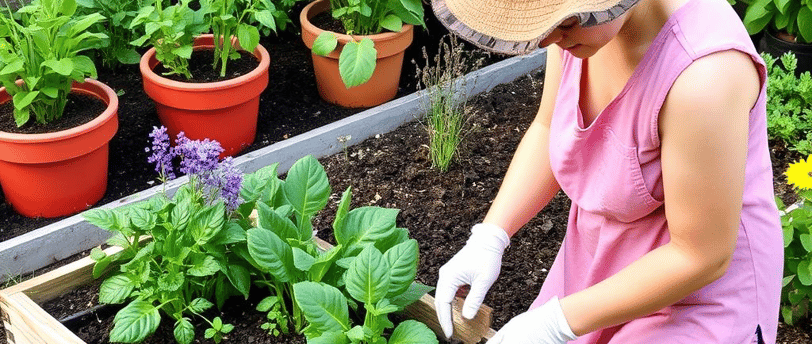A Beginner's Guide to Organic Gardening at Home
Blog post description.
♻️LIFESTYLE & SUSTAINABILITY


In recent years, organic gardening has surged in popularity among home gardeners. The allure of growing your own fresh produce without the use of synthetic pesticides and fertilizers is hard to resist. Whether you have a sprawling backyard or just a small balcony, organic gardening can be adapted to suit your living situation. This guide will cover the basics of organic gardening, including what organic gardening entails, how to get started, essential techniques, and troubleshooting challenges along the way.
What is Organic Gardening?
Organic gardening is an approach to gardening that emphasizes the use of natural processes and materials. It avoids synthetic chemicals, focusing instead on building healthy soil, promoting biodiversity, and cultivating a harmonious relationship with nature. The philosophy behind organic gardening is not merely to grow food without chemicals but to cultivate a sustainable ecosystem that can support plant and animal life.
Benefits of Organic Gardening
Healthier Produce: Organic fruits and vegetables are grown without the use of harmful pesticides, which means they are free of chemical residues. This results in healthier food choices for you and your family.
Environmental Sustainability: By avoiding synthetic fertilizers and pesticides, organic gardening helps to reduce pollution and conserve water. Organic practices enhance soil health and promote biodiversity, which are essential for a balanced ecosystem.
Taste: Many gardeners claim that organically grown vegetables and fruits taste better than their conventionally grown counterparts. The focus on soil health and biodiversity can result in richer flavor profiles.
Personal Satisfaction: There is an undeniable joy in nurturing plants from seed to harvest. Growing your own food can reduce grocery bills and provide a deep sense of accomplishment.
Getting Started with Organic Gardening
1. Choose Your Space
The first step in starting your organic garden is to evaluate your available space. Whether you're working with a large garden plot, a small backyard, or a balcony, you can adapt your gardening approach:
In-Ground Gardens: If you have ample ground space, you can create a traditional garden bed. Look for a sunny spot, as most vegetables require full sun (at least 6-8 hours of direct sunlight).
Raised Beds: Raised garden beds are a fantastic option for beginners. They offer better drainage, and you have more control over the soil quality. Use untreated wood or stone to create the beds and fill them with high-quality organic soil.
Containers: If you have limited space, container gardening is an excellent alternative. Choose pots that can accommodate the plants you wish to grow and ensure they have adequate drainage holes.
2. Soil Preparation
Healthy soil is the foundation of a successful organic garden. Start by testing your soil to understand its pH and nutrient levels. You can purchase inexpensive soil test kits at garden centers or online. Based on the test results, you may need to amend your soil with organic matter such as compost, well-rotted manure, or peat moss.
Composting: Creating your own compost is an environmentally friendly way to feed your garden. Composting kitchen scraps (vegetable peels, coffee grounds) and yard waste (grass clippings, leaves) will provide nutrient-rich organic matter that nourishes plants and improves soil structure.
3. Choose the Right Plants
Select plants that are well-suited to your climate and growing conditions. Beginners may want to start with easier-to-grow vegetables such as:
Radishes: Quick to germinate and easy to harvest.
Lettuce: Grows well in cooler weather and can be harvested in stages.
Zucchini: Produces generously with minimal care.
Tomatoes: Highly rewarding and adaptable to various growing conditions.
If you have limited space, consider vertical gardening options, such as trellises for climbing plants like peas and cucumbers.
4. Planting and Care
When planting, be sure to follow the spacing recommendations for each type of plant to allow for air circulation and growth. Overcrowding can lead to disease. Organic gardening relies heavily on sustainable practices:
Watering: Use organic mulch, such as straw or wood chips, to retain moisture in the soil and suppress weeds. Water plants deeply rather than shallowly to encourage deep root growth.
Weeding: Regularly check your garden for weeds, as they compete with your plants for nutrients and water. Hand-pulling is often the best method in organic gardening, but you can also use a hoe or a weed-tarp.
5. Pest and Disease Management
In organic gardening, the goal is to prevent issues rather than react to them:
Companion Planting: Some plants thrive when grown together. For example, planting marigolds near tomatoes can help deter nematodes.
Natural Predators: Encourage beneficial insects like ladybugs and lacewings by planting a diverse range of flowers. These insects help control pest populations naturally.
Organic Pest Control: When issues arise, there are many organic pest control options available, such as neem oil, insecticidal soaps, or diatomaceous earth, which can effectively manage pests without harming the ecosystem.
Troubleshooting Common Challenges
Organic gardening is not without its challenges. Here are a few common issues and how to address them:
Pests: If you encounter pest problems, re-evaluate your pest management strategy. Introduce natural predators or apply organic insecticidal soap.
Diseases: Plant diseases often result from poor air circulation or overcrowding. Practice crop rotation and ensure that plants are spaced adequately.
Poor Growth: If your plants are not thriving, it may be due to nutrient deficiencies. Test your soil regularly and amend it with organic fertilizers as necessary.
Conclusion
Organic gardening can be both a rewarding and educational experience. It invites you to explore the symbiotic relationships in nature while growing nutritious food for yourself and your loved ones. Whether you have a sprawling garden or a cozy balcony, you can make a meaningful contribution to your health and the environment by embarking on this green journey. The path to organic gardening is one of patience, learning, and a deepened appreciation for the natural world—so grab your gardening gloves, and get started!
